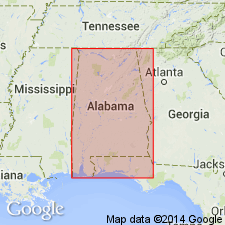
- Usage in publication:
-
- Sawyer limestone member*
- Modifications:
-
- Named
- Dominant lithology:
-
- Limestone
- AAPG geologic province:
-
- Piedmont-Blue Ridge province
Summary:
Sawyer limestone member of Talladega slate named in Shelby Co., AL. Unit is a thick-bedded fine-grained bluish-gray limestone that in places is a highly variegated marble. Sawyer is 100 to 500 ft thick and occurs in lower part of the Talladega, 4,500 ft above the base. Contains no fossils. Age is Precambrian or Paleozoic.
Source: GNU records (USGS DDS-6; Reston GNULEX).

- Usage in publication:
-
- Sawyer limestone member*
- Modifications:
-
- Revised
- AAPG geologic province:
-
- Piedmont-Blue Ridge province
Summary:
Sawyer limestone member reassigned in this report from Talladega slate to Waxahatchee slate. Separated from overlying Brewer phyllite by an interval of clay rock of brownish, greenish, or pinkish tint banded with thin yellowish, pinkish, or grayish laminae. Derivation of name given as Sawyer Cove, Shelby Co., eastern AL.
Source: GNU records (USGS DDS-6; Reston GNULEX).
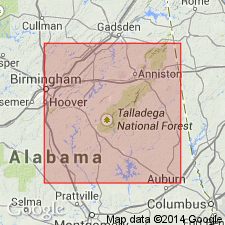
- Usage in publication:
-
- Sawyer Limestone
- Modifications:
-
- Revised
- AAPG geologic province:
-
- Piedmont-Blue Ridge province
Summary:
The Kahatchee Mountain Group is here named in the southwestern part of the Talladega slate belt in AL. It is the lower structural sequence in the belt and contains the Waxahatchee Slate, Sawyer Limestone, Brewer Phyllite, and Wash Creek Slate. Underlies the Sylacauga Marble Group or the Lay Dam Formation of the Talladega Group. The Kahatchee Mountain Group may extend farther northeast and into GA and be correlative with the Ocoee Supergroup and Chilhowee Group in the Blue Ridge belt. Age is late Precambrian and Cambrian.
Source: GNU records (USGS DDS-6; Reston GNULEX).
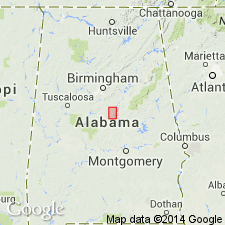
- Usage in publication:
-
- Sawyer Limestone Member
- Modifications:
-
- Revised
- AAPG geologic province:
-
- Piedmont-Blue Ridge province
Summary:
As defined here, Brewer Formation includes Sawyer Limestone Member at base. New assignment is based on revised contact relationships with other units. Age is Early Cambrian.
Source: GNU records (USGS DDS-6; Reston GNULEX).

- Usage in publication:
-
- Sawyer Limestone Member
- Modifications:
-
- Overview
- AAPG geologic province:
-
- Piedmont-Blue Ridge province
Summary:
Sawyer Limestone Member of Brewer Phyllite of Kahatchee Mountain Group is a light- to medium-gray argillaceous, silty to siliceous slightly metamorphosed limestone interlayered with lithographic to coarsely crystalline calcite and dolomite marble and interbedded locally with phyllite and meta-sandstone. Age shown as late Precambrian(?)-Cambrian(?).
Source: GNU records (USGS DDS-6; Reston GNULEX).
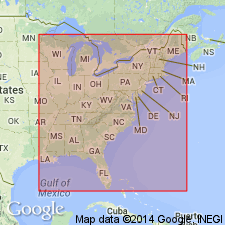
- Usage in publication:
-
- Sawyer Limestone*
- Modifications:
-
- Overview
- AAPG geologic province:
-
- Piedmont-Blue Ridge province
Summary:
Authors follow usage of Tull (1982) for Kahatchee Mountain Group of Talladega block in AL. [Formations not individually discussed but usage is inferred.] Base of Kahatchee Mountain is not exposed, nor are any crystalline basement rocks exposed in Talladega block in AL. To the northeast in GA, Kahatchee Mountain Group may unconformably overlie Middle Proterozoic basement (if Mulberry Rock Gneiss proves to be basement). Tull (1982) suggests that Kahatchee Mountain rocks are roughly equivalent to Ocoee Supergroup and Chilhowee Group rocks. McConnell and Abrams (1984) portray northeastern end of Talladega belt, which would be Kahatchee Mountain Group, as continuous into Great Smoky Group. More recently, archaeocyathids have been found in Jumbo Dolomite (McKinney and others, 1988), which is stratigraphically below Sylacauga Marble Group of Tull (1982) and its base is interlayered with lithologies of Kahatchee Mountain Group. Jumbo is correlated with Early Cambrian Shady Dolomite of Valley and Ridge province. The Kahatchee Mountain rocks, like Ocoee rocks, are volcanic-free.
Source: GNU records (USGS DDS-6; Reston GNULEX).
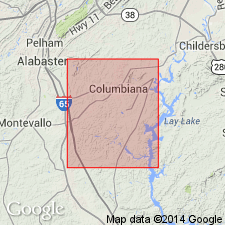
- Usage in publication:
-
- Sawyer Limestone Member
- Modifications:
-
- Overview
- AAPG geologic province:
-
- Piedmont-Blue Ridge province
Summary:
Although Butts (1926; 1940) described the Sawyer as limestone, no limestone was recognized during this study and all marble proved to be dolomitic. Base of the Sawyer consists of interlayered thin-bedded pink and gray, fine-grained, locally pyritic dolomitic marble and slate. Bedding varies from 6 to 12 in. Higher in the section, the marble varies in color from gray to light brown, is medium to coarsely crystalline and occurs in beds up to 2 ft thick. At the junction of Buxahatchee and Waxahatchee Creeks, dark-gray medium-grained dolomitic marble is arenaceous and contains medium- to coarse-grained quartz clasts. Locally, the dolostone is interlayered with very dusky-red slate of the Brewer. The Sawyer, 98 ft thick at Sawyer Cove, thins to the southeast and to the southwest and is absent in the Coosa River area and along the eastern edge of the study area. No age diagnostic fossils have been recovered from the Member. Underlies unnamed calcareous hematitic wacke below the conglomeratic sandstone member. Age of the Brewer and its members is Early Cambrian(?) in this report.
Source: GNU records (USGS DDS-6; Reston GNULEX).
For more information, please contact Nancy Stamm, Geologic Names Committee Secretary.
Asterisk (*) indicates published by U.S. Geological Survey authors.
"No current usage" (†) implies that a name has been abandoned or has fallen into disuse. Former usage and, if known, replacement name given in parentheses ( ).
Slash (/) indicates name conflicts with nomenclatural guidelines (CSN, 1933; ACSN, 1961, 1970; NACSN, 1983, 2005, 2021). May be explained within brackets ([ ]).

